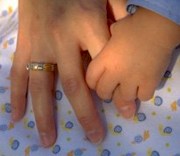Hypoplastic left heart syndrome (HLHS) is rare but serious. It is the most common cause of death from heart disease during the first week of life. With surgical repair or a heart transplant, about 70% of children born with HLHS live at least 5 years.
In infants born with HLHS, the left ventricle and the aorta are small and underdeveloped and can't supply the body with enough blood.
Also in HLHS, the mitral and aortic valves are often narrow or absent. Without these openings, the left ventricle is shut off from the rest of the heart and the aorta. That means the left ventricle cannot pump any oxygen-rich blood into the body. Instead, the oxygen-rich blood returns to the right side of the heart through an atrial septal defect (ASD), a hole in the wall that divides the right and left sides of the heart.
In newborns, the atrial septal defect lets oxygen-rich blood reach the body because blood can pass from the right side of the heart and into the aorta, without going through the left side of the heart. The right side of the heart pumps blood into the pulmonary artery, and then a channel called the ductus arteriosus connects the pulmonary artery to the aorta. The ductus arteriosus is an important pathway in the fetal heart, but it closes in the first few days after birth.
Until the ductus closes, oxygen-rich blood enters the right side of the heart through the atrial septal defect. The right side of the heart then pumps blood into the pulmonary artery, and the ductus arteriosus lets blood flow into the aorta. The aorta carries this oxygen-rich blood to the body.
This means that for the first few days after birth, the baby may seem normal because oxygen-rich blood is reaching the rest of the body. But when that ductus closes, oxygen-rich blood no longer has a way of entering the aorta.
When there isn't enough oxygen-rich blood reaching the body, the baby's skin may turn blue. This is called cyanosis. Once this happens, the baby needs surgery or a heart transplant right away.
How is it treated?
There are two options for treating HLHS. One is heart transplantation, and the other is a three-part operation called the Norwood procedure. The survival rates for heart transplantation and the Norwood procedure are about the same.
In most cases, the Norwood procedure is used because of the shortage of donor hearts for transplantation.
The three steps of the Norwood procedure are
- The stage I Norwood procedure. This surgery needs to be done soon after birth. The aorta is connected directly to lower-right chamber (the right ventricle) so the ductus arteriosus can be closed.
- The stage II Norwood procedure (also called the bi-directional Glenn shunt). This is usually done when the baby is about 6 months old. The superior vena cava, which carries oxygen-poor blood to the heart from the upper part of the body, is connected to the pulmonary artery, which carries oxygen-poor blood into the lungs.
- The stage III Norwood procedure (also called the Fontan procedure). This is usually done when the child is 1 to 3 years old. The inferior vena cava, which carries oxygen-poor blood to the heart from the lower part of the body, is connected to the pulmonary artery, which carries this blood into the lungs.
Return to main topic: Congenital Heart Disease
MedlinePlus
https://medlineplus.gov/ency/article/001106.htm
Hypoplastic left heart syndrome
American Heart Association
www.heart.org/HEARTORG/Conditions/CongenitalHeartDefects/
AboutCongenitalHeartDefects/Single-Ventricle-Defects_UCM_307037_Article.jsp
Single Ventricle Syndromes
Texas Adult Congenital Heart Center (TACH)
www.bcm.edu/healthcare/care-centers/congenital-heart
This Baylor College of Medicine program enables patients with congenital heart disease to receive a seamless continuation of care from birth to old age.
Updated August 2016



